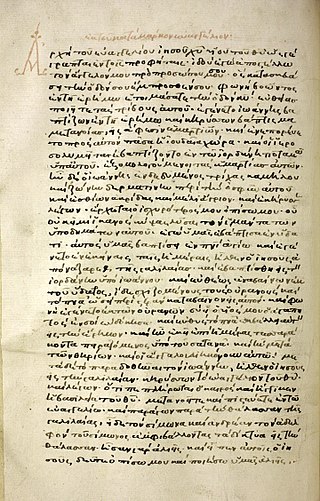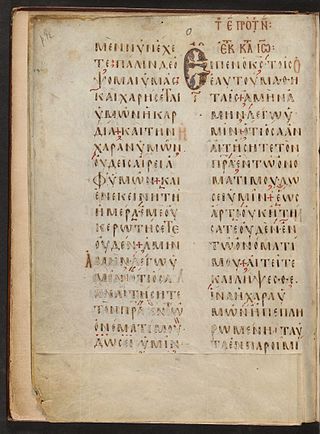
The Codex Petropolitanus Purpureus, designated by N or 022, ε19, is a Greek New Testament codex containing the four Gospels written on parchment. Using the study of comparative writing styles (palaeography), it has been assigned to the 6th century CE.

Codex Cyprius, designated by Ke or 017, ε71, or Codex Colbertinus 5149, is a Greek uncial manuscript of the four Gospels, written on parchment. It is one of the few uncial manuscripts with the complete text of the four Gospels, and it is one of the more important late uncial manuscripts. It was brought from Cyprus to Paris.

Codex Regius is a Greek uncial manuscript of the New Testament written on parchment. It is designated by siglum Le or 019 in the Gregory-Aland numbering of New Testament manuscripts, and ε56 in the von Soden numbering of New Testament manuscripts. Using the study of comparative writing styles (palaeography), it has been assigned to the 8th century. The manuscript has several gaps. Textual critic Frederick H. A. Scrivener described it as "by far the most remarkable document of its age and class."

Codex Campianus is designated as "M" or "021" in the Gregory-Aland cataloging system and as "ε 72" in the Von Soden system. It is a Greek uncial manuscript of the New Testament, dated palaeographically to the 9th century. The manuscript has complex contents. It has marginalia and was prepared for liturgical (religious) use.

Codex Mosquensis II designated by V or 031, ε 75, is a Greek uncial manuscript of the Gospels, dated palaeographically to the 9th century. The manuscript is lacunose.
Codex Dublinensis is a Greek uncial manuscript of the New Testament Gospels, written on parchment. It is designated by Z or 035 in the Gregory-Aland numbering of New Testament manuscripts, and ε 26 in the von Soden numbering of New Testament manuscripts. Using the study of comparative writing styles (palaeography), it has been dated to the 6th century CE. The manuscript has several gaps.

Codex Basilensis A. N. IV. 2 is a Greek minuscule manuscript of the entire New Testament, apart from the Book of Revelation. Using the study of comparative writings styles (palaeography), it is usually dated to the 12th century CE. It is known as Minuscule 1, δ 254, and formerly designated by 1eap to distinguish it from minuscule 1rK.

Minuscule 69, δ 505, known as the Codex Leicester, or Codex Leicestrensis, is a Greek minuscule manuscript of the New Testament on paper and parchment leaves. Using the study of comparative writing styles (palaeography), it has been dated to the 15th century. Some leaves of the codex are lost. It has been examined and collated by many palaeographers and textual critics. Although it is of a late date, its text is remarkable from the point of view of textual criticism.

Minuscule 579, ε 376, is a Greek minuscule manuscript of the New Testament Gospels, written on parchment. Using the study of comparative writing styles (palaeography), it has been dated to the 13th century. It was formerly labelled as 80e. The manuscript has some missing portions of text.
Lectionary 26, designated by siglum ℓ26. It is a Greek manuscript of the New Testament, on vellum leaves. Palaeographically it has been assigned to the 13th-century.
Minuscule 238 (in the Gregory-Aland numbering), A145 (Soden), is a Greek minuscule manuscript of the New Testament, on parchment. Palaeographically it has been assigned to the 11th or 12th century. It has marginalia.
Minuscule 300 (in the Gregory-Aland numbering), A141 (Soden), is a Greek minuscule manuscript of the New Testament, on parchment. Palaeographically it has been assigned to the 11th century. It has marginalia.
Minuscule 392, Θε23 (Soden), is a Greek minuscule manuscript of the New Testament, on parchment. Paleographically it has been assigned to the 12th century. It has marginalia.

Lectionary 183, designated by siglum ℓ183 is a Greek manuscript of the New Testament, written on parchment in uncial letters. Biblical scholars Westcott and Hort labelled it by 38e,and biblical scholar Frederick H. A. Scrivener by 257e. Using the study of comparative writings styles (palaeography), it has been assigned to the 10th century. The manuscript has some missing portions and gaps at the end and inside, but they were supplied by a later hand. It is faded in parts.
Minuscule 471, α 136, is a Greek minuscule manuscript of the New Testament, on a parchment. Palaeographically it has been assigned to the 12th century. Scrivener labelled it by number 510. The manuscript has no complex contents.

Minuscule 473, α1390, is a Greek minuscule manuscript of the New Testament, made from parchment. Using the study of comparative writing styles (palaeography), it has been assigned to the 11th century. Biblical scholar Frederick H. A. Scrivener described it as "one of the most splendid manuscripts extant" which contained "many remarkable variations", and labelled it by the number 512. It has liturgical books and full marginal notes.
Minuscule 472, α 1386, is a Greek minuscule manuscript of the New Testament, written on parchment. Using the study of comparative writing styles (palaeography), it has been assigned to the 13th century. Biblical scholar and textual critic Frederick H. A. Scrivener labelled it by number 511.
Minuscule 475, α 138, is a Greek minuscule manuscript of the New Testament, on parchment. Palaeographically it has been assigned to the 11th century. Scrivener labelled it number 515. It has full marginalia.
Minuscule 498, δ 402, is a Greek minuscule manuscript of the New Testament, on parchment. Palaeographically it has been assigned to the 14th-century. Scrivener labelled it by number 584. The manuscript is lacunose.

Lectionary 296 (Gregory-Aland), designated by siglum ℓ296 is a Greek manuscript of the New Testament, on parchment. Palaeographically it has been assigned to the 10th century. The manuscript is very lacunose.













